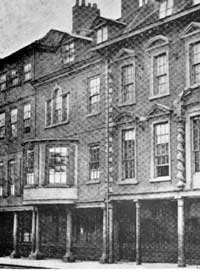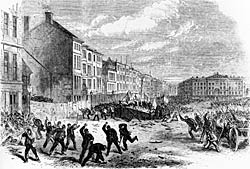
 |
Smith's Bank (the building with the bow window) on South Parade, shortly before demolition in 1874. |
 |
Rioting in Nottingham Market Place during the 1860s. |
Structual
Standing Buildings
The National Westminster Bank on the Old Market Square, Nottingham, stands on the site of the branch of Smith’s Bank, attacked by rioters in 1790.
Colwick Hall, where the rioters of 1831 went on 10 October, is now in private ownership and has been much restored since the early nineteenth century.
Nottingham Castle was left as a burnt out shell after the reform bill riots, but restored by Nottingham Corporation in the 1870s and reopened in 1878 as the first provincial museum of fine art.
The Beeston Silk Mill, rebuilt following the riot of 11 October 1831, is now incorporated within the premises of a shop on the corner of Beeston High Road and Wollaton Road, in Beeston.
Landscape
Nottingham market place was the scene of many of the most notorious election riots. It was laid out as the current Processional Way in 1929, and is due to be altered again in 2006.